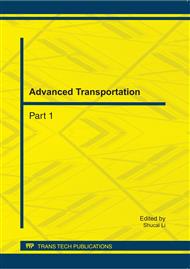p.648
p.653
p.659
p.664
p.669
p.677
p.681
p.685
p.690
Balancing between Headway and Frequency Scheduling for Bus Service
Abstract:
Bus networks occupy less space in city streets, and compared to other kinds of public transportation, need less investment cost. An accurate bus operation schedule which considers actual arriving and departure time is essential for bus companies, due to high passenger demand. In real-world cases, there are daily differences in the frequency of bus dispatch from the terminal, and headway of buses between each bus bay along their route, depending on peak hour traffic and resulting congestion. In this research we studied effective parameters for preparation of proper bus operation scheduling. Measures are essential to ensure that buses receive priority over other traffic, if they are to be attractive to passengers. Finally, we suggest some solutions for lessening interval time in headway and frequency scheduling for bus services. Data obtained from an actual bus operation in the city of Tehran in Iran was used in this study.
Info:
Periodical:
Pages:
669-673
Citation:
Online since:
September 2011
Authors:
Keywords:
Price:
Сopyright:
© 2011 Trans Tech Publications Ltd. All Rights Reserved
Share:
Citation:


